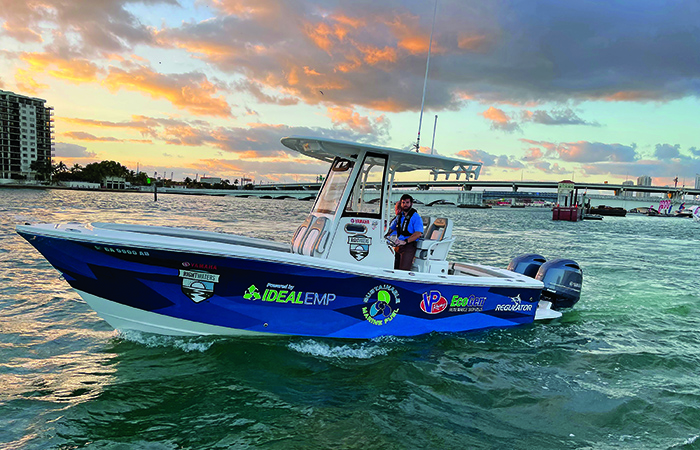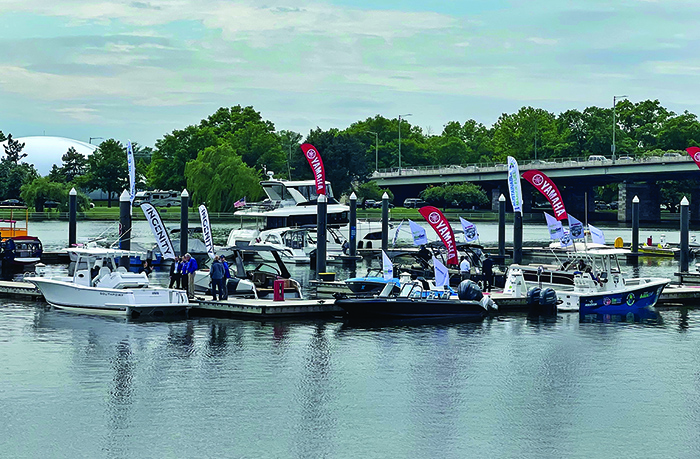Advertisement
A new range of ethanol-free fuels, tested by the NMMA with good results, may reduce your boat’s emissions. Let’s look a little deeper.

Photo: Yamaha
Recreational boaters are increasingly looking for ways to reduce their environmental impact, but not everyone wants or can afford to buy an electric or hybrid boat. A new generation of alternative marine fuels is offering a possible solution. These fuels, according to the National Marine Manufacturers Association (NMMA) and others, may significantly cut carbon emissions without sacrificing a boat’s performance and range.
The advantage, according to NMMA, is that these fuels can be used with existing recreational boats, eliminating the need for expensive upgrades to fuel systems or engines. They’re considered by many to be “sustainable” because they’re produced largely from plant material such as corn and other nonpetroleum products such as animal fats and waste oil, fats, and greases.
With approximately 12 million registered boats in the U.S., many of which will remain in use for decades, alternative fuels could play an important role in minimizing recreational boating emissions.
“The biggest and most meaningful way to minimize CO2 emissions is to do so via the existing fleet,” said Jeff Wasil, director of environment, health & safety compliance at NMMA.
Sustainable alternatives
Three alternative marine fuel products were showcased at the 2023 Miami Boat Show, including the drop-in diesel alternative, Neste MY Renewable Diesel. The fuel has been tested using standards set by the American Society for Testing and Materials. It is made entirely from materials such as cooking oil, animal fat, and food industry waste. Neste claims it reduces greenhouse gas emissions by up to 75% over the fuel’s life cycle compared to conventional fossil-based diesel. The boat show also highlighted two ethanol-free gasoline alternatives: PurFuels (distributed by Hyperfuels) and EcoGen 93 by VP Racing.
PurFuels is an ethanol-free reformulated gasoline that contains Gevo biobutanol (16.1% vol.), approved by NMMA. Leftover starch from corn that’s used for producing high-protein animal feeds is separated from the kernel to create energy-dense liquids. According to an NMMA press release, PurFuels can reduce CO2 emissions by up to 30% relative to conventional fossil-based gasoline.
EcoGen 93 is an ethanol-free gasoline made with LyondellBasell’s Ideal EMP, a promising new fuel that the marine industry is currently investigating. According to an NMMA press release, EcoGen 93 reduces CO2 emissions by up to 30% more than E10 gasoline.
Both PurFuels and EcoGen 93 are designed to be “drop-in” fuels, which means they’re compatible with existing recreational boat engines and require no changes to the fuel system or engine.

Neste renewable diesel burns cleaner than petroleum-based diesel. It’s already available on the West Coast.
Is biobutanol safe for my engine?
Any marine mechanic will tell you that ethanol, a biofuel commonly added to gasoline, can wreak havoc on marine engines. In the presence of water, it’s susceptible to phase separation that can deteriorate fuel system components and lead to catastrophic engine failure. So it’s fair to ask: Are these next-gen biofuels any better?
Isobutanol (also referred to as biobutanol) is an alcohol produced by fermentation from the same biomass feedstocks as ethanol, including corn. However, it has different properties than ethanol. Unlike ethanol, isobutanol does not absorb water and is resistant to phase separation, though the degree of that resistance is unclear. Isobutanol is also more energy dense than ethanol, containing 90% of the energy content of gasoline, compared with 67% for ethanol.
In 2015, NMMA and the American Boat and Yacht Council (ABYC), under the direction and guidance of the U.S. Department of Energy and Argonne National Laboratory, concluded a five-year program that evaluated the use of biobutanol in recreational marine engines. The U.S. Coast Guard as well as several engine manufacturers including Volvo Penta, Evinrude, Yamaha, Mercury Marine, Honda, Tohatsu, and Indmar also participated in the research.
A gamut of tests were performed in the lab and field looking at everything from engine power to cold-start performance using biobutanol fuel blends. The report concluded that biobutanol fuel blends (up to 16.1%) resulted in no engine failures or boat performance issues. “A lot of research went into it before we, as an industry, went ahead and approved the use of biobutanol,” said Wasil.
While the research is promising and engines showed no unusual wear or durability issues after 350 hours of testing, it remains to be seen how these fuels will impact engines over 20, 30, or 40 years (the average marine gasoline engine runs for 1,500 hours before needing a major overhaul). As with any new technology, time will serve as the ultimate test.
Are biofuels really more sustainable?
Anyone who has followed biofuel news may wonder if these new fuels are more earth-friendly. Critics point to the environmental and societal impacts of growing biofuel feedstocks including expanded farmlands, damaged biodiversity, increased water use, diminishing forests, increased price of agricultural commodities, and reduced food security.
Some studies suggest that the U.S. Renewable Fuel Standard, which mandates a minimum volume of renewable fuel like ethanol in gasoline, has probably inadvertently increased greenhouse gas emissions due to the increased use of fertilizers and the clearing of land for crop production. Questions about biofuels and their impact on emissions and the environment can’t all be answered any time soon. However, advocates suggest that these fuels may offer a unique solution for recreational boating, particularly given some of the industry-specific challenges of moving toward electrification.
“Everybody thinks, ‘Just throw an electric motor on a boat and it’s good to go,’” said Wasil. “But [marine is] different from automotive from a performance perspective.” It comes down to physics: It takes far more energy to push a boat through the water than it does to propel a relatively frictionless car along a road. While electrification has seen uptake with sailboats and dinghies, planing and sports boats remain a challenge because of their energy requirements. “If you drive an electric car … the range is not too bad. [With an electric boat], depending on the size, you’re looking at an 80% to 90% reduction in range,” said Wasil.
Additionally, we don’t use our boats as frequently as we use our cars, which means there’s less opportunity to offset the CO2 emissions that went into their manufacturing. “You could actually increase your CO2 emissions because you’re not running the boat enough to offset any emissions that were put into the production of a battery,” said Wasil.
Looking to the future, Wasil sees even greater potential for biofuels in the marine industry. “In the context of a 147 billion gallon [on-road] gasoline market, you just can’t make enough biofuels to offset. But when you look at marine being just under a billion gallons a year … that’s very much achievable with renewables without stretching our crops and food supply.”

Several major engine manufacturers championed alternative fuels at the 2023 American Boating Congress in Washington, D.C.
What’s the cost and availability?
The price premium for the alternative fuels available today can vary. “We’re seeing anywhere from about 15 cents to about a dollar more over conventional ethanol E10 gasoline depending on the type of renewable fuel and octane level,” said Wasil. “The challenge is getting fuel to the marinas in a cost-effective way.” He expects availability to improve as economies of scale are achieved.
Boaters in certain parts of the country can access these fuel options now. For instance, Neste MY Renewable Diesel is available on the West Coast and meets California’s Low Carbon Fuel Standard. Boaters in Texas can fuel up with PurFuels gasoline, and soon those in Missouri, Illinois, Wisconsin, and the East Coast from Maryland to Maine will also have access. EcoGen fuel will be available in limited quantities in Texas this summer, with plans for expansion to Florida by 2024.
Boaters can improve access
“If having access to alternative marine fuels is important to you, make sure your local marinas and gas stations know about it,” said BoatUS Government Affairs manager David Kennedy. “We saw that with boaters asking for E0 [ethanol-free] gasoline. The retailers that could sell it responded to the market.”
Kennedy is also a member of the Alternative Marine Fuels Task Force where representatives from the boating industry are working on safe solutions to integrate alternative fuels into the boating ecosystem.
“BoatUS is there as the voice for boat owners,” said Kennedy, “We know the energy mix is going to change, and we look forward to those improvements. We just need to make sure that what’s available will work for boating. For some folks, electric will be fabulous. For others, for the immediate future anyway, it will be hard to replace the energy density of diesel or gasoline.”
But the future, and whether we continue to use fossil fuels, is not yet certain. BoatUS Magazine will cover the developments and report back as we see how these fuels do in the field.
